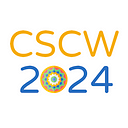How do you make decisions about moving a conference online during a pandemic? Attendees are globally dispersed, and have varying challenges from childcare to stable internet access.There’s no rulebook, there’s no plan ready to go, because the circumstances are new. How do you make decisions rapidly, in a changing environment, when there are looming deadlines and big tradeoffs?
If you’re CSCW 2020, you ask your community what they need, what their constraints are, and what’s most important to them. And if you’re CSCW 2021, you build on that by asking that same community “how did we do, and what can we do better next time?”
More directly, we ask. We’re Michael Ann DeVito and Sarah Gilbert, the Meta Co-Chairs for CSCW 2020 and 2021. If you haven’t heard of Meta Co-Chairs before, no worries — it’s new! Briefly, we have two jobs on the organizing committee. First, we help maintain CSCW’s capacity for self reflection by collecting, analyzing, and disseminating data about the conference itself, including your feedback — data which helps us plan the next conference. Second, we promote and enable research at and on the conference itself.
Going all-online has made our job more crucial than ever, because the community’s feedback is more crucial than ever. We are still figuring out what does and does not work when moving a conference with many moving pieces online, so it’s more important than ever to stop and reflect before making big decisions for next year. That’s why we’re asking you to fill out this year’s Post-Conference Survey ASAP — we need to know what you all think worked, and where we can improve next year.
Moving to a virtual conference has also opened up new opportunities to study many topics our community cares about, right at our own conference. This past year we put out a call for studies, which enabled us to help find ideal places to deploy research interventions in ways that supported both the research and the conference itself. We will be doing the same this coming year, and we encourage you to think about what we can learn from studying ourselves. If you’re thinking big — or just want to get a head start — we’d love to start having those conversations with you now.
In fact, we’d love to start having all sorts of conversations about CSCW with you now. We’re always available at meta2021@cscw.acm.org, and we’re both frequent visitors to CSCW Meta.
When the results of this survey come in, the 2021 Organizing Committee will take them into account during planning, and we will be releasing the anonymized data to the community. In the interim, we wanted to give you a window into how we used earlier survey data to inform CSCW 2020 planning.
Summary of Pre-conference Results
The pre-conference survey was distributed in July and received 123 responses, most of whom anticipated presenting their work at the conference (n=83). The results of this survey are a good example of just how complicated key decisions can be, and how conference planning is an exercise in making smart decisions around trade-offs.
One of the best examples of these trade-offs is paper presentations. Both presenters and attendees clearly prefered live synchronous presentations over recorded asynchronous videos. However, open-ended responses surfaced significant technical and accessibility-related concerns around live presentations: timezone and timing issues, bandwidth issues, and difficulty captioning live presentations and discussions. Each of these issues could also slow down the pace of a session, taking time away from extended discussion — which the survey also indicated was heavily preferred by all.
Another good example of trade-offs is overall conference format and timing. We laid out several options, including the original conference timing, offset scheduling, multiple blocks throughout the day, and a fully asynchronous conference. Asynchronous was by far the least popular option, with keeping the original conference times as the most popular option, suggesting the importance of keeping live events. There were also preferences for a shorter conference day (M=5 hours), with most respondents preferring shorter blocks of sustained time (M=3.8 hours). However, there was also a strong preference for fewer parallel tracks, significantly constraining the scheduling of a shorter day, and an attendee base across at least 15 disparate timezones, a challenge to live scheduling. Moreover, open ended questions highlighted the importance of flexibility and concerns over screen fatigue. They also suggested a solution: merge synchronous and asynchronous structures, so that live sessions could be supplemented with text-based discussions.
We also asked about socialization, one of the biggest challenges moving online. Preferences were for structured, synchronous social events, and responses to opened ended questions indicated the importance of preserving the social aspects of conferences. In fact, this was the largest concern, with 40 out of 48 responses to the open ended question asking, “What does not work about virtual conferences?” focussing on a lack of social opportunities. This will continue to be a focus of improvement going into 2021.
